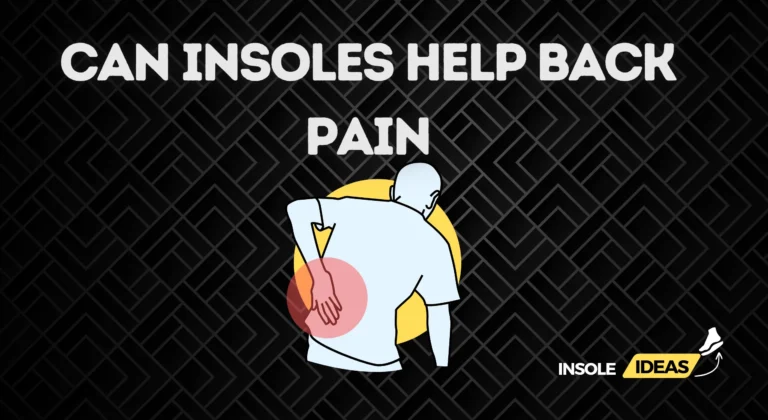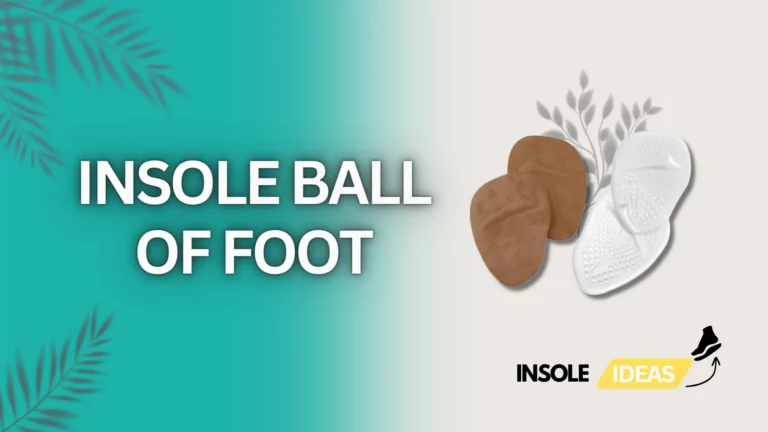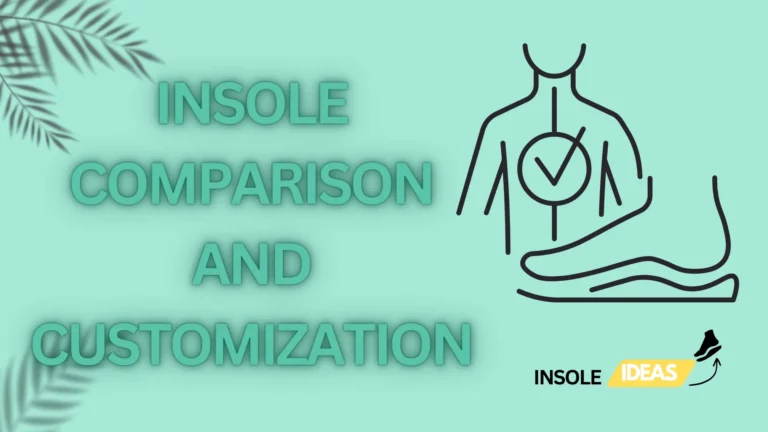The Ultimate Guide to High Arch Insoles: Relieving Pain and Improving Comfort
High arches, or pes cavus, are characterized by an unusually high arch on the foot’s inner side. This condition can lead to discomfort and complications due to inadequate weight distribution and shock absorption during activities like walking or running.
Understanding High Arches
High arches result from a natural variation in foot structure, where the arch is higher than usual. This condition can be inherited or developed over time due to neurological disorders, muscle imbalances, or certain medical conditions.
Individuals with high arches may experience foot pain, instability, and difficulty finding correctly fitting footwear. Understanding the biomechanics of high arches is crucial in selecting appropriate support solutions, such as specialized insoles designed to alleviate discomfort and enhance stability.
Importance of Proper Foot Support
Proper foot support is essential for individuals with high arches to mitigate the risk of developing problems like plantar fasciitis, metatarsalgia, or stress fractures. High arch insoles offer targeted support to the arch area, redistributing pressure evenly and promoting proper foot alignment during movement.
Providing adequate cushioning and arch support, these insoles help reduce strain on the feet and lower limbs, improving overall comfort and mobility. Moreover, they play a significant role in preventing overpronation, a common issue associated with high arches that can lead to ankle instability and other complications.
Common Problems Associated with High Arches
High arches can predispose individuals to various foot-related problems, impacting their daily activities and overall quality of life. Understanding these common issues is essential for effective management and prevention.
Foot Pain
One of the primary complaints among individuals with high arches is foot pain, particularly in the arch area and the balls of the feet. The elevated arch puts excessive pressure on specific parts of the foot, leading to discomfort, inflammation, and even the development of calluses or corns.
Plantar Fasciitis
Plantar fasciitis is a prevalent condition characterized by inflammation of the plantar fascia, the band of tissue that connects the heel to the toes. In individuals with high arches, the increased tension on the plantar fascia due to poor weight distribution can exacerbate this condition, resulting in heel pain and stiffness, especially during the first steps in the morning or after prolonged rest periods.
Overpronation
Overpronation occurs when the foot rolls inward excessively while walking or running, causing the arch to collapse and misalign the lower limbs. High arches can contribute to overpronation by reducing the foot’s ability to absorb shock and maintain stability during gait, increasing the risk of injuries such as shin splints, stress fractures, and Achilles tendonitis.
Impact on Posture
High arches can affect the feet and the body’s overall alignment and posture. The elevated arches can cause imbalances in weight distribution, leading to compensatory movements in the ankles, knees, hips, and spine. Over time, these misalignments can contribute to chronic pain, muscle fatigue, and postural abnormalities if left unaddressed.
Benefits of High Arch Insoles
High arch insoles offer a range of benefits for individuals with pes cavus, addressing specific needs and providing enhanced comfort and support during daily activities.
Arch Support
One of the primary benefits of high arch insoles is their ability to provide targeted support to the arch area of the foot. By filling the gap between the high arch and the ground, these insoles help distribute weight more evenly across the foot, reducing strain and pressure on the arch and surrounding tissues. This added support promotes proper foot alignment, alleviating discomfort and improving stability during movement.
Shock Absorption
High arch insoles are designed with materials that offer excellent shock absorption properties, helping to cushion the foot and attenuate impact forces during walking, running, or standing for extended periods. By absorbing shock effectively, these insoles reduce stress on the feet, ankles, and lower limbs, minimizing the risk of injuries and fatigue and enhancing overall comfort.
Alignment Correction
Individuals with high arches often experience issues related to improper foot alignment, such as overpronation or supination. High arch insoles incorporate features like arch support and medial or lateral wedging to help correct alignment abnormalities and promote a more neutral foot position during gait. By encouraging proper alignment, these insoles can prevent excessive strain on the muscles and joints, reducing the risk of overuse injuries and improving overall biomechanical efficiency.
Pressure Redistribution
High arch insoles redistribute pressure across the foot’s surface, reducing localized pressure points and areas of high stress. By evenly distributing weight, these insoles help prevent the formation of calluses, corns, and other foot deformities associated with high arches. Additionally, by reducing pressure on specific areas of the foot, such as the balls of the feet or the heel, these insoles alleviate discomfort and improve overall comfort, allowing individuals to engage in activities with less pain and fatigue.
Types of High Arch Insoles
Various types of high arch insoles are available to address different needs and preferences, offering varying levels of support, cushioning, and customization options.
Cushioned Insoles
Cushioned insoles are designed with soft, plush materials like foam or gel to provide superior cushioning and shock absorption. These insoles are ideal for individuals with high arches who require extra support and comfort during activities like walking or standing for prolonged periods. Cushioned insoles help reduce pressure on the feet and provide a cushioned surface for optimal comfort and support.
Semi-Rigid Insoles
Semi-rigid insoles offer support and flexibility, making them suitable for individuals with high arches who require moderate to firm support. These insoles typically feature a combination of supportive materials like plastic or carbon fiber and cushioning materials like foam or gel. Semi-rigid insoles provide excellent arch support and stability while allowing for flexibility during movement.
Custom Orthotics
Custom orthotics are specially designed insoles customized to fit an individual’s foot’s unique shape and contours. These insoles are typically prescribed by a podiatrist or orthopedic specialist and are fabricated based on a thorough evaluation of the patient’s foot structure, gait pattern, and specific needs. Custom orthotics offer precise support and alignment correction, making them highly effective in addressing foot-related issues such as high arches, overpronation, or plantar fasciitis.
Gel Insoles
Gel insoles are made with soft, silicone-based gel materials that offer superior cushioning and shock absorption. These insoles conform to the foot’s shape, providing customized support and comfort. Gel insoles are ideal for individuals with high arches who require maximum cushioning and pressure relief, as they help reduce impact forces and alleviate discomfort during activities like walking, running, or standing for long periods.
How to Measure Your Arch Height
Measuring your arch height accurately is crucial in selecting the right high arch insoles that provide optimal support and comfort. Various methods are available, including simple at-home techniques and specialized measurement tools.
Wet Test Method
The wet test method is straightforward and requires only a shallow pan of water and a piece of paper. To perform this test, thoroughly soak your foot’s sole and step onto the paper, ensuring equal weight distribution. Examine the footprint left behind to determine your arch type. High arches typically show a narrow, curved footprint with minimal contact between the middle portion of the foot and the paper.
Arch Height Measurement Tools
For more precise arch height measurement, consider using specialized arch height measurement tools available at podiatry clinics or specialty footwear stores. These tools may include devices like arch rulers or digital scanners that analyze the contours of your foot and provide detailed measurements of the arch height. Consulting with a podiatrist or footwear specialist can help you determine the most accurate method for measuring your arch height and selecting appropriate high arch insoles.
Tips for Selecting the Right High Arch Insoles
Choosing the right high arch insoles can significantly impact your comfort, support, and overall foot health. Consider the following tips to ensure you select the best insoles for your specific needs and preferences.
Consultation with a Podiatrist
Before purchasing high arch insoles, consider consulting with a podiatrist or foot specialist to assess your foot structure, biomechanics, and any existing foot-related issues. A professional evaluation can help identify the underlying causes of your high arches and recommend appropriate treatment options, including custom orthotics or specialized insoles tailored to your unique needs.
Trying Different Types
Explore various high arch insoles, such as cushioned, semi-rigid, or custom orthotics, to determine which ones offer the best combination of support, cushioning, and comfort for your feet. Consider trying different brands, materials, and styles to find the insoles that fit your feet comfortably and address your specific concerns, such as arch support, shock absorption, or alignment correction.
Comfort and Fit
When selecting high arch insoles, prioritize comfort and fit to ensure optimal performance and effectiveness. Choose insoles that contour to the shape of your feet and provide adequate cushioning and support without causing discomfort or pressure points. Consider moisture-wicking materials, antimicrobial properties, and breathable designs to enhance comfort and maintain foot hygiene during wear. Take the time to test the insoles in different types of footwear and activities to ensure they meet your comfort and performance requirements.
Proper Care and Maintenance of High Arch Insoles
Proper care and maintenance of high arch insoles are essential to ensure their longevity and effectiveness in providing support and comfort to your feet. By following these guidelines, you can prolong the life of your insoles and maximize their benefits.
Cleaning Instructions
Regular cleaning of high arch insoles helps prevent dirt, sweat, and odor buildup, maintaining hygiene and freshness. To clean your insoles, gently wipe them with a damp cloth or sponge soaked in mild soapy water. Avoid submerging the insoles in water or using harsh chemicals, as these can damage the materials and affect their performance. Allow the insoles to air dry thoroughly before returning them to your shoes. For stubborn stains or odor, consider using a specialized shoe deodorizer or disinfectant spray formulated for insoles.
Replacement Guidelines
Over time, high arch insoles may wear out or lose their supportive properties due to regular use and exposure to moisture and friction. Replacing your insoles every 6 to 12 months is recommended, depending on the frequency of use and the extent of wear and tear. Inspect your insoles regularly for signs of deterioration, such as flattened cushioning, worn-out arch support, or visible damage. If your insoles no longer provide adequate support or comfort, it’s time to replace them with a new pair to ensure continued foot health and functionality.
Storage Tips
Proper storage of high arch insoles can help maintain their shape and structural integrity when not in use. Store your insoles in a clean, dry place away from direct sunlight, heat, and moisture, as prolonged exposure to these elements can cause the materials to degrade and deteriorate prematurely. Avoid folding or creasing the insoles, damaging the supportive structures, and affecting their performance. Consider using a dedicated insole storage case or container to keep your insoles organized and protected when not in use. By storing your insoles properly, you can prolong their lifespan and ensure they remain effective in providing support and comfort to your feet.
Real-Life Testimonials: Users’ Experiences with High Arch Insoles
Real-life testimonials from individuals who have used high arch insoles can provide valuable insights into their effectiveness and benefits in addressing foot-related issues. Here are some success stories and challenges that users of high-arch insoles face.
Success Stories
Many individuals have experienced significant relief from foot pain, improved comfort, and enhanced mobility after using high arch insoles. Users often report reduced fatigue, increased stability, and improved posture when wearing correctly fitting insoles. Success stories include individuals who have resumed their favorite activities, such as running, hiking, or standing for long periods, without experiencing discomfort or pain. Some users also note improvements in overall foot health and fewer common foot problems like plantar fasciitis or shin splints.
Challenges and Solutions
While high arch insoles offer numerous benefits, some users may encounter challenges during the initial adjustment period or due to improper fit or selection. Common challenges include discomfort, irritation, or blisters caused by insoles that are too rigid or not correctly contoured to the foot shape. Additionally, individuals with unique foot characteristics or medical conditions may require customized or specialized insoles to address specific needs effectively. Solutions to these challenges may involve consulting with a podiatrist or footwear specialist to assess fit and compatibility, trying different types or brands of insoles, or incorporating additional cushioning or support accessories to enhance comfort and performance. By addressing these challenges proactively, users can optimize their experience with high arch insoles and enjoy the benefits of improved foot health and functionality.
Addressing Common Misconceptions About High Arch Insoles
Despite their effectiveness in providing support and comfort, high arch insoles are sometimes subject to misconceptions and misunderstandings. By addressing common misconceptions, we can clarify the benefits and suitability of high arch insoles for individuals with various foot types and lifestyles.
High Arch Insoles Are Only for Athletes
Contrary to popular belief, high arch insoles are not exclusively designed for athletes or individuals engaged in high-impact activities. While athletes may benefit from the support and shock absorption provided by these insoles during sports or training, high arch insoles are suitable for anyone with pes cavus seeking relief from foot pain, improved stability, and enhanced comfort during daily activities. Whether walking, standing, or participating in recreational activities, high arch insoles can help alleviate discomfort and promote better foot health for individuals of all ages and activity levels.
High Arch Insoles Are Uncomfortable
Another common misconception about high arch insoles is that they are uncomfortable or cause additional foot problems. While it’s true that improperly fitting or poorly designed insoles may cause discomfort or irritation, high-quality insoles that are correctly selected and fitted can significantly enhance comfort and support for individuals with high arches. By choosing insoles with appropriate cushioning, arch support, and materials that suit your foot shape and activity level, you can minimize discomfort and enjoy the benefits of improved foot health and functionality. Additionally, consulting with a podiatrist or footwear specialist can help address concerns or issues related to insole comfort and fit, ensuring a positive experience and optimal results.
Addressing Common Misconceptions About High Arch Insoles
Misconceptions about high arch insoles may prevent individuals from experiencing their benefits entirely. Addressing these misconceptions can provide clarity and encourage informed decisions about foot care and support.
High Arch Insoles Are Only for Athletes
While high arch insoles are commonly associated with athletic footwear, they are not exclusive to athletes. Individuals with high arches may experience discomfort and foot-related issues in various activities, including daily tasks like walking or standing for extended periods. High arch insoles offer support and cushioning to alleviate pain, improve stability, and promote proper foot alignment, benefiting individuals of all lifestyles and activity levels. Whether you’re an athlete or seeking relief from foot pain, high arch insoles can provide support and comfort to enhance your overall foot health and well-being.
High Arch Insoles Are Uncomfortable
Some people may avoid using high arch insoles due to the misconception that they are uncomfortable or cause additional foot problems. However, discomfort associated with insoles is often the result of improper fit or poor-quality materials rather than the concept of high arch support itself. High-quality insoles that are appropriately selected and fitted can significantly improve comfort and support for individuals with high arches. By choosing insoles with appropriate cushioning, arch support, and materials tailored to your foot shape and activity level, you can minimize discomfort and enjoy the benefits of improved foot health and functionality. Consulting with a podiatrist or footwear specialist can help address concerns or issues related to insole comfort and fit, ensuring a positive experience and optimal results.
DIY Solutions for High Arch Support
In addition to high arch insoles, individuals with pes cavus can explore various do-it-yourself (DIY) solutions to strengthen their arches and alleviate discomfort. Incorporating exercises and stretching techniques into your daily routine can help improve foot strength, flexibility, and overall foot health.
Exercises to Strengthen Arches
Strengthening exercises target the muscles of the feet and lower legs, helping to improve arch stability and support. Exercises include toe curls, arch lifts, and marble pickups, which can be performed using simple props like towels, marbles, or resistance bands. These exercises help strengthen the foot’s intrinsic muscles, improving arch integrity and reducing the risk of overuse injuries associated with high arches.
Stretching Techniques
Stretching techniques focus on increasing flexibility and mobility in the muscles and connective tissues of the feet and lower legs. Stretching exercises like calf, Achilles tendon, and toe stretches can help alleviate tension and tightness in the arch area, promoting a better range of motion and reducing discomfort. Incorporating stretching into your daily routine can help prevent muscle imbalances and maintain optimal foot health, especially for individuals with high arches who may be prone to stiffness and limited mobility.
High Arch Insoles for Specific Activities
High arch insoles are designed to provide targeted support and comfort for specific activities, catering to each activity’s unique needs and demands. Whether you’re running, walking, or standing for prolonged periods, high arch insoles are available to enhance your performance and reduce discomfort.
Running
For runners with high arches, high arch insoles offer superior shock absorption, arch support, and stability to minimize the risk of injuries and enhance running efficiency. These insoles are typically made with durable materials and feature cushioning technologies to provide optimal comfort and protection during high-impact activities.
Walking
High arch insoles for walking are designed to provide support and cushioning to reduce fatigue and discomfort during extended periods of walking. These insoles offer targeted arch support and shock absorption to alleviate pressure on the feet and promote a more natural gait pattern, allowing for a more enjoyable and comfortable walking experience.
Standing for Prolonged Periods
Individuals who spend long hours on their feet, such as healthcare professionals, retail workers, or service industry workers, can benefit from high arch insoles designed for prolonged standing. These insoles offer extra cushioning and support to reduce fatigue and discomfort, allowing individuals to maintain better posture and foot health throughout the day. Providing targeted support to the arch area and redistributing pressure evenly across the foot, these insoles help alleviate strain and prevent foot-related problems associated with prolonged standing.
High Arch Insoles for Specialized Footwear
High arch insoles are not limited to just one type of footwear; they can be adapted to various specialized footwear to provide support and comfort tailored to specific needs and activities.
Dress Shoes
Individuals wearing dress shoes regularly may benefit from high arch insoles that fit discreetly into narrow or low-profile footwear. These insoles offer targeted arch support and cushioning while maintaining a sleek and professional appearance. Look for dress shoe insoles with slim profiles and flexible materials to ensure a comfortable fit without compromising style.
Work Boots
For individuals in occupations that require heavy-duty footwear, such as construction workers or warehouse employees, high arch insoles for work boots provide essential support and protection. These insoles are typically made with durable materials and feature enhanced shock absorption and stability to withstand the rigors of demanding work environments. Look for work boot insoles with reinforced arch support and heel cups to provide maximum foot support and comfort during long hours.
Athletic Shoes
Athletes and active individuals can benefit from high arch insoles explicitly designed for athletic shoes. Whether you’re a runner, a basketball player, or a fitness enthusiast, high arch insoles offer superior support, cushioning, and stability to enhance performance and reduce the risk of injuries. Look for athletic shoe insoles with advanced cushioning technologies and moisture-wicking properties to keep your feet comfortable and dry during intense workouts or competitions.
Addressing High Arch Insoles for Children and Teens
High arch insoles are not just for adults; they can also benefit children and teens who may experience discomfort or foot-related issues due to high arches. It’s essential to consider developmental factors and choose the right insoles to support growing feet effectively.
Developmental Considerations
Children’s feet undergo significant changes and development during growth, making it essential to consider developmental factors when selecting high arch insoles. Look for insoles that offer flexible support and room for natural foot movement to accommodate children’s feet’ changing shape and size. Avoid rigid or restrictive insoles that may hinder proper foot development or cause discomfort.
Choosing the Right Insoles for Growing Feet
When choosing high arch insoles for children and teens, prioritize comfort, support, and durability. Look for insoles with soft, cushioning materials that provide adequate arch support without causing discomfort or irritation. Consider consulting with a pediatrician or podiatrist to assess your child’s foot structure and recommend appropriate insoles tailored to their needs and activity level. Choosing the right insoles for growing feet can support healthy foot development and prevent foot-related issues in children and teens with high arches.
High Arch Insoles and Foot Health Conditions
High arch insoles can be crucial in managing various foot health conditions, providing targeted support and relief for individuals with specific medical needs.
Diabetes
Individuals with diabetes are at increased risk of foot complications due to reduced sensation, poor circulation, and foot deformities. High arch insoles designed for diabetic foot care offer gentle support and cushioning to reduce pressure points and prevent ulcer formation. These insoles are typically made with soft, diabetic-friendly materials and feature seamless designs to minimize friction and irritation, promoting optimal foot health and reducing the risk of complications.
Arthritis
Arthritis can cause pain, stiffness, and inflammation in the joints of the feet, making it challenging to find comfortable footwear. High arch insoles for arthritis offer targeted support and cushioning to alleviate pressure on the affected joints and improve overall comfort and mobility. Look for insoles with shock-absorbing properties and contoured arch support to relieve arthritis-related foot pain and discomfort.
Pregnancy
Pregnancy can lead to changes in foot structure and weight distribution, causing discomfort and foot-related issues such as arch pain and swelling. High arch insoles for pregnancy offer gentle support and cushioning to relieve pressure on the feet and reduce discomfort during pregnancy. Look for insoles with arch support and heel cushioning to provide stability and alleviate strain on the feet and lower limbs. Additionally, consider maternity insoles with moisture-wicking properties to keep your feet dry and comfortable throughout pregnancy. High arch insoles can help pregnant individuals maintain better foot health and overall comfort during this transformative time by supporting the arches and reducing pressure on the feet.
The Science Behind High Arch Insoles
Understanding the science behind high arch insoles involves examining the biomechanics of the foot and their impact on gait.
Biomechanics of the Foot
The biomechanics of the foot refer to the study of how the bones, muscles, and joints work together to support body weight and facilitate movement. In individuals with high arches, the foot’s natural shock-absorbing mechanism may be compromised, leading to increased pressure on specific areas of the foot and reduced shock absorption during activities like walking or running. High arch insoles are designed to address these biomechanical issues by providing targeted support to the arch area, redistributing pressure evenly across the foot, and promoting proper foot and lower limb alignment. High arch insoles help reduce strain on the feet and lower limbs, alleviate discomfort, and enhance overall foot health and function by supporting the arch and improving biomechanical efficiency.
Impact on Gait
Gait refers to how a person walks or moves, including the pattern of foot placement, weight distribution, and propulsion. Individuals with high arches may exhibit abnormal gait patterns, such as supination or excessive outward rolling of the foot, which can increase the risk of injuries and impact overall mobility and stability. High arch insoles are designed to correct these gait abnormalities by providing support and stability to the arch area, encouraging a more neutral foot position, and promoting smoother, more efficient gait mechanics. High arch insoles help enhance overall mobility, stability, and comfort during walking, running, or other weight-bearing activities by improving gait dynamics and reducing excessive stress on the feet and lower limbs.
Case Studies: High Arch Insoles in Action
Examining real-life case studies highlights the effectiveness of high arch insoles in addressing specific foot-related issues and improving overall quality of life.
Case Study 1: Runner’s Knee Relief
A runner experiencing chronic knee pain sought relief through high arch insoles. After consulting with a podiatrist and undergoing gait analysis, the runner was fitted with custom high arch insoles to correct biomechanical imbalances and reduce knee stress. With regular use of the insoles, the runner experienced significant improvement in knee pain and could resume training without discomfort. The high arch insoles provided essential support and stability, allowing the runner to maintain proper foot alignment and prevent overuse injuries during running activities.
Case Study 2: Improved Posture and Back Pain Reduction
Individuals with high arches and chronic back pain sought relief through high arch insoles. After wearing the insoles for a few weeks, the individual noticed a significant improvement in posture and reduced back pain. The high arch insoles provided targeted support to the arch area, promoting proper alignment of the feet, ankles, and lower limbs. By redistributing pressure evenly across the foot and reducing strain on the back muscles, the insoles helped alleviate discomfort and improve overall spinal alignment. The individual reported feeling more comfortable and supported throughout the day, allowing for better mobility and quality of life.
Summary: Enhancing Comfort and Mobility with High Arch Insoles
High arch insoles offer numerous benefits for individuals seeking relief from foot pain and discomfort.
Recap of Benefits
High arch insoles provide targeted support to the arch area, redistributing pressure evenly across the foot and promoting proper alignment of the feet and lower limbs. Improving biomechanical efficiency and reducing strain on the feet and lower limbs, these insoles help alleviate discomfort, improve stability, and enhance overall foot health and function. Whether you’re an athlete, a professional, or someone seeking relief from foot-related issues, high arch insoles offer a practical solution to enhance comfort and mobility during daily activities.
Importance of Proper Foot Support
Proper foot support is essential for optimal foot health and function, especially for individuals with high arches. High arch insoles provide the necessary support and stability to alleviate pain, reduce fatigue, and prevent injuries associated with high arches. Individuals can enjoy improved comfort, mobility, and overall quality of life by investing in high-quality insoles and prioritizing proper foot support.
conclusion
high arch insoles provide versatile solutions for foot pain, stability, and comfort. Backed by science and real-life cases, they offer practical biomechanical support, dispelling misconceptions about exclusivity or discomfort. They enhance mobility and overall foot health and are suitable for various footwear and conditions. With proper understanding and use, high arch insoles offer significant benefits for improved comfort and quality of life.






